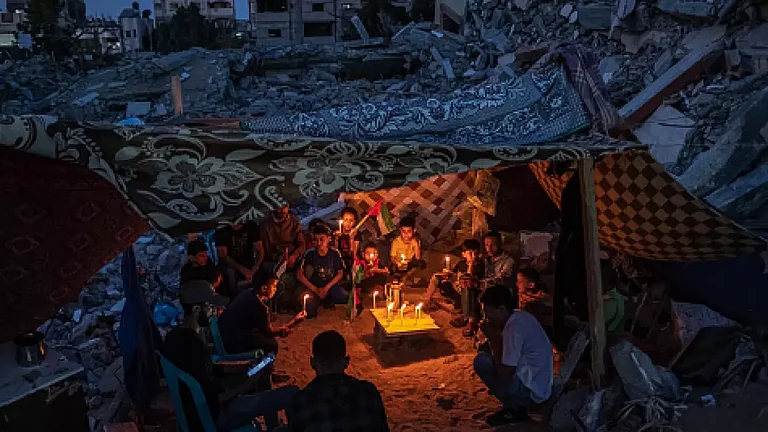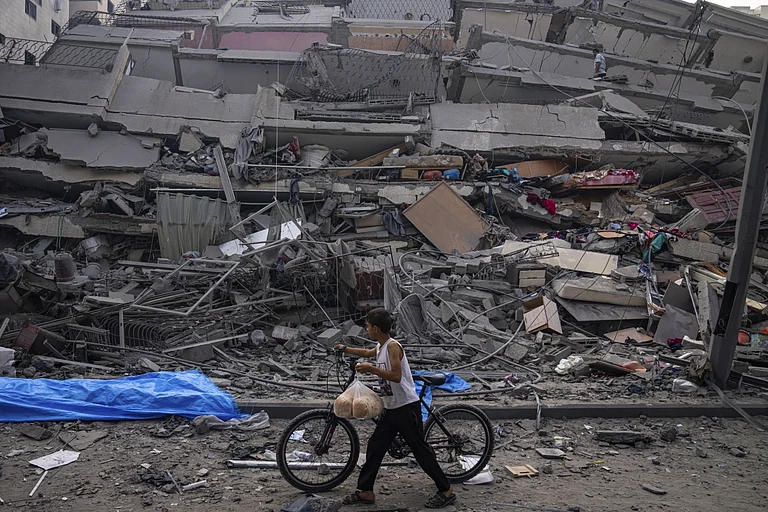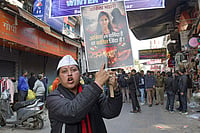Gaza is starving. A week ago, the UN declared that the Gaza strip was in IPC Phase five, which is the final stage of hunger. There are severe food and water shortages which have led to widespread malnutrition, and UN and other aid workers have reported that at least 88 children have died of starvation in the past fortnight. News bodies such as AFP and AP have also issued statements saying the same and expressing worry for their reporters who are currently in the region. One UN report describes children and families as “walking corpses” due to food and water deprivation.
While Israel on Sunday July 27 let in more aid—the IDF shared videos on its X showing planes dropping what are purportedly aid packages on the strip, and reportedly over 100 trucks are to be let in, distribution of aid remains a huge problem. Reports from the Strip say that the aid is not enough to ease the starvation crisis in Gaza and dropping it from planes has led to stampedes as people rush to pick up the supplies. Israel also resumed power to a critical water treatment plant in Gaza but clean water is reportedly scarce.
On Monday morning/ Sunday night, IDF intercepted an aid ship The Handala which was carrying baby formula and was manned by civilians, reports said.
The UN, the Human Rights Watch and other international humanitarian organisations have accused Israel of using starvation as a weapon of war, which is a war crime under the UN convention of rights. The UN special rapporteur Francesca Albanese has warned in her reports that famine-like conditions are likely already happening in the Gaza strip, with malnutrition rates quadrupling among children in under‑five age groups
Israel has defended its position by saying its policies are not to deprive the civilian population of the Gaza strip but aimed at reducing supplies to Hamas, which is considers a terrorist organisation.
Prime Minister Netanyahu has confirmed that despite the “pauses” Israel’s military campaign will continue until Hamas is disbanded and releases its Israeli hostages.
In Outlook Magazine's January 11, 2025 issue 'War And Peace', journalist and historian Vijay Prashad says, "There are children in Gaza, for example, who were born in 2006 and are now eighteen, who have seen wars at their birth in 2006, then in 2008-09, 2012, 2014, 2021 and now, in 2023-24. The gaps between these major bombardments have been punctuated by smaller bombardments, as noisy and as deadly. A survey of the children in Gaza by War Child Alliance found that death feels imminent for 96 per cent of them—traumatised by the murder of their family members and terrorised by the sound and ferocity of the bombings."
In Outlook Magazine's January 21 2025 issue 'War And Democracy', journalist Shweta Desai writes, "Tightened restrictions due to the blockade, which prevents the entry of commercial trucks, mean there is not enough fresh food, flour for bread, drinking water or concrete to build shelters. The 2.1 million people in Gaza have been living on bread, canned food and high-energy biscuits for the past 14 months. Earlier, around 500 commercial trucks were allowed to enter Gaza daily to deliver essential goods. But since the October 7 attack by Hamas on Israel, only 60 to 70 trucks are allowed entry into Gaza, severely restricting the flow of supplies and exacerbating the humanitarian crisis."
Timeline of Key Events (Oct 2023–July 2025)
7 October 2023: Hamas launches a large-scale incursion into southern Israel, killing over 1,200 people and kidnapping approximately 250 hostages. Israel responds with airstrikes and begins a major military campaign in Gaza
Late October–November 2023: Israel expands into Gaza with ground offensive; limited humanitarian corridors open. A seven-day ceasefire and hostage exchange occurs in November (240 Palestinian women and minors released in exchange for hostages), but collapses by December. A mistaken Israeli strike kills hostages in mid-December, igniting strong backlash
Throughout 2024: Escalating conflict in Gaza, especially in Khan Younis and Rafah. International pressure grows over civilian deaths and aid restrictions. Ceasefire efforts periodically emerge, but fighting continues into mid‑2024
January 15 2025: Israel and Hamas agree to a ceasefire deal brokered by the U.S., Egypt, and Qatar. The truce begins on 19 January and includes phased hostage-prisoner exchanges. First phase ends 1 March with partial exchanges; plans for second phase stall due to disagreements and Israel's refusal to withdraw from key Gaza corridors
March 2 2025: Israel imposes a total aid blockade, preventing deliveries of food, water, and medicine. Food prices soar, bakeries and humanitarian kitchens run out of supplies, and child malnutrition spikes with over 60,000 severe cases by May
March 18 2025: Israel launches Operation Might and Sword, ending the ceasefire with a surprise air‑and‑ground offensive. More than 400 Palestinians die on first day. Ground assaults expand through March into mid‑May to seize territory and cut Gaza in half via the Netzarim Corridor
May 7 2025: Wehda Street airstrike hits a crowded market area in Gaza City, killing at least 33 civilians and injuring around 90. This marks an intensification of urban strike tactics during the broader campaign
May–June 2025: Israel begins limited easing of restrictions, allowing a minimal number of aid trucks daily and introducing tactical pauses. The UN, WHO and NGOs warn of famine-scale suffering; dozens of children are estimated to have died from hunger. Meanwhile multiple countries call for ceasefire, and the UN Security Council's resolution demanding unconditional aid access is vetoed by the U.S.
July 15-16 2025: A Bogotá summit of 32 nations under the Hague Group addresses the Gaza war. Twelve countries agree on six measures to stop Israeli military support, arms flows, and to pursue international legal accountability
July 27 2025: Israel allows more humanitarian aid access and resumes water treatment infrastructure support, but only during limited daily pauses and under tight restrictions. Estimated severe malnutrition and starvation deaths among children continue to rise. International condemnation grows, and calls for a ceasefire and expanded humanitarian corridors intensify


























